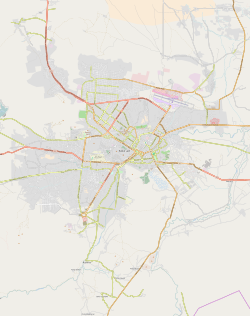July 2016 Kabul bombing
| July 2016 Kabul bombing | |
|---|---|
| Part of the War in Afghanistan (2015–present) | |
 | |
| Location | Dehmazang Square, Kabul, Afghanistan |
| Date | 23 July 2016 c. 14:30 AST[1] (UTC+04:30) |
| Target | Hazara civilians |
Attack type | Suicide bombing[2] |
| Deaths | 80+[3][2][4] |
| Injured | 260[5] |
| Perpetrators | Islamic State |
| Motive | Anti-Shi'ism |
| Part of a series on |
| Hazaras |
|---|
 |
|
|
|
On 23 July 2016, a twin bombing[6] occurred in the vicinity of Dehmazang square in Kabul, capital of Afghanistan, when protesters, mostly from the Shiite Hazara ethnic minority, were marching against the TUTAP mega power project.[3][7] At least 80 people were killed and 260 injured.[2][4][3] The terrorist group Islamic State of Iraq and the Levant has claimed responsibility.
The attack was the deadliest in Kabul since 2001.[8] Afghan President Ashraf Ghani, in a live television address, declared the following day (24 July) a day of national mourning and promised action against the culprits.[1][3]
Background
The Hazaras are the third largest ethnic group of Afghanistan, mostly Shia in a Sunni state, forming up to 15% of the Afghan population.[9] Hazaras have been subject to discrimination and genocide since the establishment of current Afghanistan by Emir Abdur Rahman Khan. The Hazara community has long been persecuted by the Taliban and thousands have been killed since 1990.[10]
The TUTAP (Turkmenistan-Uzbekistan-Tajikistan-Afghanistan-Pakistan) is a multi-million dollar power project backed by the Asian Development Bank and World Bank[11] to make electricity accessible to more people in Afghanistan.[12] The project's initial assessment recommended the TUTAP route through the Bamyan Province,[13] a Hazara populated province in the Central Highlands, but in 2013[1] it was re-routed via Salang Pass.[12]
The Hazara minority of Afghanistan protested the decision to re-route the TUTAP project. The civil activists of Kabul organised a march to protest on 6 May 2016, naming the movement جنبش روشنایی (literally "Enlightenment Movement"). Subsequent negotiations between the protesters and government officials were inconclusive. Therefore a second peaceful demonstration was organised on 23 July 2016.
Thousands of people attended the demonstration on 23 July 2016. It started west of Kabul at around 07:00 and ended at Dehmazang Square, where the government had placed containers and trucks to stop demonstrators from marching towards the presidential palace.[14] Protesters were planning to make camp here at the end of the protest.[1]
Before the march, the government had warned organizers of the possibility of an attack.[1]
Bombings
At 14:30, two militants detonated explosive belts when protesters were returning home at the end of the demonstrations. Security agencies claim they had intelligence reports warning about movement of bombers.[14] CNN reported, citing Afghan police, that a third attacker was killed before detonating his bomb, though only two attackers were described in the claim of responsibility.[5]
Perpetrators
The attack was carried out by two Islamic State fighters, according to the affiliated Amaq News Agency.[3][14][15] According to VOA, the ISIS statement also said the attack was meant to warn the Hazara to stop fighting with the Syrian government in the Syrian Civil War,[16] under such units as Liwa Fatemiyoun.[citation needed]
The Taliban denied involvement in the attack.[17]
Reactions
See also
- List of terrorist incidents in July 2016
- List of Islamist terrorist attacks
- 30 June 2016 Afghanistan bombings
- Kabul attack on Canadian Embassy Guards
- Kunduz-Takhar highway hostage crisis
References
- ^ a b c d e "The Latest: 10-Day Ban on Public Gatherings in Afghanistan". Associated Press via ABC News. 23 July 2016. Retrieved 24 July 2016.
- ^ a b c Harooni, Mirwais (23 July 2016). "Islamic State claims responsibility for Kabul attack, 80 dead". Reuters. Retrieved 24 July 2016.
- ^ a b c d e "Kabul explosion: Islamic State 'admits attack on Hazara protest'". BBC. 23 July 2016. Retrieved 24 July 2016.
- ^ a b "Kabul: At least 80 feared killed, more than 200 wounded in IS claimed bomb attack". The Indian Express. 23 July 2016. Retrieved 24 July 2016.
{{cite web}}: Italic or bold markup not allowed in:|publisher=(help) - ^ a b Visser, Steve; Popalzai, Masoud (23 July 2016). "ISIS claims Afghanistan explosion that kills dozens". CNN. Retrieved 24 July 2016.
- ^ "More madness, more bloodshed in Afghanistan". Pakistan Today. 23 July 2016. Retrieved 24 July 2016.
{{cite web}}: Italic or bold markup not allowed in:|publisher=(help) - ^ "BBC Farsi". BBC Afghanistan. 23 July 2016. Retrieved 23 July 2016.
- ^ Rasmussen, Sune Engel (23 July 2016). "Isis claims responsibility for Kabul fatal bomb attack on Hazara protesters". The Guardian. Retrieved 23 July 2016.
{{cite web}}: Italic or bold markup not allowed in:|publisher=(help) - ^ AP (Karim Sharifi) (24 July 2016). "Afghanistan marks day of national mourning after huge attack". The Seattle Times. Retrieved 24 July 2016.
- ^ Saleem Ali (16 January 2012). "Helping the Hazara of Afghanistan and Pakistan". National Geographic. Retrieved 24 July 2016.
- ^ "The TUTAP Interconnection Concept and CASA-1000". 6 June 2014. Retrieved 24 July 2016.
- ^ a b Putz, Catherine (10 May 2016). "TUTAP Energy Project Sparks Political Infighting in Afghanistan". The Diplomat. Retrieved 24 July 2016.
{{cite web}}: Italic or bold markup not allowed in:|publisher=(help) - ^ "Technical Assistance Consultant's Report" (PDF). Asian Development Bank. May 2013. Retrieved 24 July 2016.
- ^ a b c "ISIL-claimed blasts kill dozens in Kabul Hazara protest". Al Jazeera. Retrieved 24 July 2016.
- ^ "IS’ ‘Amaq News Agency Claims Dual Suicide Bombing in Kabul", from SITE Intelligence Group
- ^ "IS Attack Kills 80 During Protest in Kabul". VOA. 23 July 2016. Retrieved 25 July 2016.
- ^ AFP Kabul (23 July 2016). "80 killed in twin explosions during Kabul protest, IS claims responsibility". Hindustan Times. Retrieved 23 July 2016.
{{cite web}}: Italic or bold markup not allowed in:|publisher=(help)
